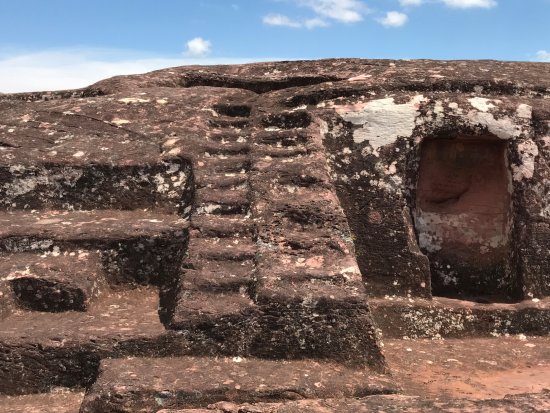SAMAIPATA, A MEGALITHIC CITADEL

Unraveling the Mysteries of Samaipata: Bolivia’s Enigmatic Archaeological Site
Nestled in the breathtaking landscapes of Bolivia, the site of Samaipata stands as a testament to the region’s rich cultural history and its enduring mysteries. Often overshadowed by more famous sites like Tiwanaku or Machu Picchu, Samaipata captivates visitors with its strange features and enigmatic aura. This blog post delves into the intriguing aspects of Samaipata, inviting adventurers and history enthusiasts alike to explore its secrets.
The Historical Context of Samaipata
Samaipata is believed to have been a significant ceremonial site for ancient indigenous cultures, particularly the Tiwanaku civilization, which flourished between 400 and 1000 AD. While much remains unknown about the specific functions of Samaipata, archaeological studies suggest it may have played a role in religious practices, astronomical observations, and social gatherings.
The site is characterized by its unique architecture, featuring intricately carved stone structures, terraces, and pathways. These elements hint at a sophisticated understanding of engineering and aesthetics, raising questions about the technological capabilities of the civilizations that inhabited this region.
Mysterious Features of Samaipata

Unusual Stone Structures: One of the most striking aspects of Samaipata is its collection of stone formations. Many of these structures are not only architecturally unique but also exhibit bizarre alignments and carvings that suggest they may have had specific purposes, possibly related to astronomy or spiritual rituals. The precision with which these stones were cut and arranged is still a subject of debate among archaeologists.
Astronomical Alignments: Samaipata is particularly intriguing for its possible astronomical significance. Certain formations align with solar and lunar events, indicating that the site may have been used for celestial observations. This connection to the cosmos adds a layer of mystique, inviting visitors to ponder how ancient cultures interacted with the heavens.
The Whispering Stones: Local legends speak of the “whispering stones” found at Samaipata. Visitors have reported hearing faint sounds or echoes when standing near certain rocks, leading to speculation about their historical or spiritual significance. Some believe these stones hold the voices of the past, creating a connection between the present and ancient inhabitants.
The Lost Pathways: Winding through the site are pathways that seem to disappear into the hills. These paths, believed to be part of a larger network, lead explorers to secluded areas filled with more ruins and intriguing rock formations. The disappearance of these pathways adds an element of adventure and mystery, inviting visitors to explore the unknown.
The Enigmatic Atmosphere
What truly sets Samaipata apart is its atmosphere. Surrounded by the stunning natural beauty of the Bolivian highlands, the site evokes a sense of wonder and curiosity. The silence, interrupted only by the wind and distant wildlife, creates a serene backdrop for contemplation. As you wander through the ruins, it’s easy to feel connected to the ancient peoples who once inhabited this land.

Visiting Samaipata
For those interested in visiting Samaipata, the journey is as rewarding as the destination. Located near the town of La Paz, the site can be reached through a combination of local transport and guided tours. The relatively low foot traffic compared to other archaeological sites means visitors can experience the tranquility and mystery of Samaipata without the crowds.

